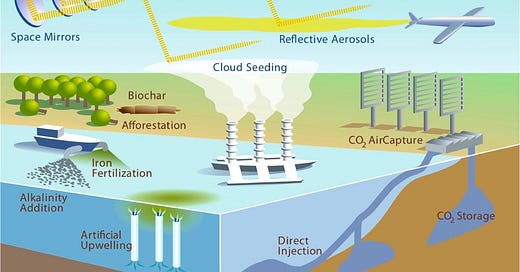On July 25, I published a review of Under a White Sky, Elizabeth Kolbert’s recent book on our species’ effects on the environment. One of the book’s chapters concentrates on geoengineering. As it is one of the less familiar topics found in that book, I thought that I’d devote today'’s newsletter to the subject. And—given the state of our warmed-up globe, with unprecedented wildfires and droughts, plus the state of our politics, both in the U.S. and abroad—geoengineering is something we all need to know more about and need to talk about.
Geoengineering has not been undertaken, not yet. It is still on the drawing board. The concept envisions large-scale projects on a planetary scale, designed to mitigate global heating. For some folks geoengineering includes small-scale operations like tree planting for carbon sequestration or cloud seeding that induces rain on a local scale, but most of the time when people use the term they are talking about big-picture projects. Geoengineering sounds totally new, but the idea goes back a long way. It was the subject of a paper in the first issue of the scientific journal Climate Change in 1977. The paper’s proposal, establishing a carbon-capture system by pumping CO2 into the Mediterranean Ocean’s undercurrents, seems both modest and a bit crazy compared to today’s thinking. Geoengineering remained a topic of a relatively small group of scientists, academics, and policy makers through the eighties and nineties, only entering the popular press quite a bit later, in 2006.1
Some of the ideas that crop up when people talk about geoengineering sound like they came from a bunch of speed freaks who spent too much time at a Star Trek convention. One idea is to shoot satellites into orbit that would act like great parasols in the sky, shading the Earth from the sun. The concept ranges from the very large—a 1,200 mile-wide reflective shield—to thousands of tiny “umbrellas” orbiting in a band around the Earth. Another idea involves artificial clouds. Notice how much cooler you feel when a cloud crosses the sky on a hot day? Some have proposed doing this on a grand scale, deploying great ships that would take ocean water and spew it into the atmosphere.
We can build theoretical frameworks around a giant bumbershoot or thousands of tiny parasols in orbit, but no one knows exactly what will happen. We don’t have an experimental Planet B to try these things out on. If we undertook such projects, all the beta testing would be done on Mother Earth. If we mess things up, well…
Keep reading with a 7-day free trial
Subscribe to The Green Dispatch to keep reading this post and get 7 days of free access to the full post archives.



